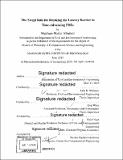| dc.contributor.advisor | John R. Willaims and Qiqi Wang. | en_US |
| dc.contributor.author | Alhubail, Maitham Makki(Maitham Makki Hussain) | en_US |
| dc.contributor.other | Massachusetts Institute of Technology. Department of Civil and Environmental Engineering. | en_US |
| dc.date.accessioned | 2019-12-13T18:52:52Z | |
| dc.date.available | 2019-12-13T18:52:52Z | |
| dc.date.copyright | 2019 | en_US |
| dc.date.issued | 2019 | en_US |
| dc.identifier.uri | https://hdl.handle.net/1721.1/123222 | |
| dc.description | Thesis: Ph. D. in Computational Science and Engineering, Massachusetts Institute of Technology, Department of Civil and Environmental Engineering, 2019 | en_US |
| dc.description | Cataloged from PDF version of thesis. | en_US |
| dc.description | Includes bibliographical references (pages 103-104). | en_US |
| dc.description.abstract | This thesis describes a method to accelerate parallel, explicit time integration of unsteady PDEs. The method is motivated by our observation that network latency, not bandwidth or computing power, often limits how fast PDEs can be solved in parallel. The method is called the swept rule of space-time domain decomposition. Compared to conventional, space-only domain decomposition, it communicates similar amount of data, but in fewer messages. The swept rule achieves this by decomposing space and time among computing nodes in ways that exploit the domains of influence and the domain of dependency, making it possible to communicate once per many time steps with no redundant computation. By communicating less often, the swept rule effectively breaks the latency barrier, advancing on average more than one time step per round-trip latency of the network. The thesis describes the algorithms, presents simple theoretical analysis to the performance of the swept rule, and supports the analysis with numerical experiments. | en_US |
| dc.description.statementofresponsibility | by Maitham Makki Alhubail. | en_US |
| dc.format.extent | 104 pages | en_US |
| dc.language.iso | eng | en_US |
| dc.publisher | Massachusetts Institute of Technology | en_US |
| dc.rights | MIT theses are protected by copyright. They may be viewed, downloaded, or printed from this source but further reproduction or distribution in any format is prohibited without written permission. | en_US |
| dc.rights.uri | http://dspace.mit.edu/handle/1721.1/7582 | en_US |
| dc.subject | Civil and Environmental Engineering. | en_US |
| dc.title | The swept rule for breaking the latency barrier in time-advancing PDEs | en_US |
| dc.type | Thesis | en_US |
| dc.description.degree | Ph. D. in Computational Science and Engineering | en_US |
| dc.contributor.department | Massachusetts Institute of Technology. Department of Civil and Environmental Engineering | en_US |
| dc.identifier.oclc | 1129585911 | en_US |
| dc.description.collection | Ph.D.inComputationalScienceandEngineering Massachusetts Institute of Technology, Department of Civil and Environmental Engineering | en_US |
| dspace.imported | 2019-12-13T18:52:52Z | en_US |
| mit.thesis.degree | Doctoral | en_US |
| mit.thesis.department | CivEng | en_US |
